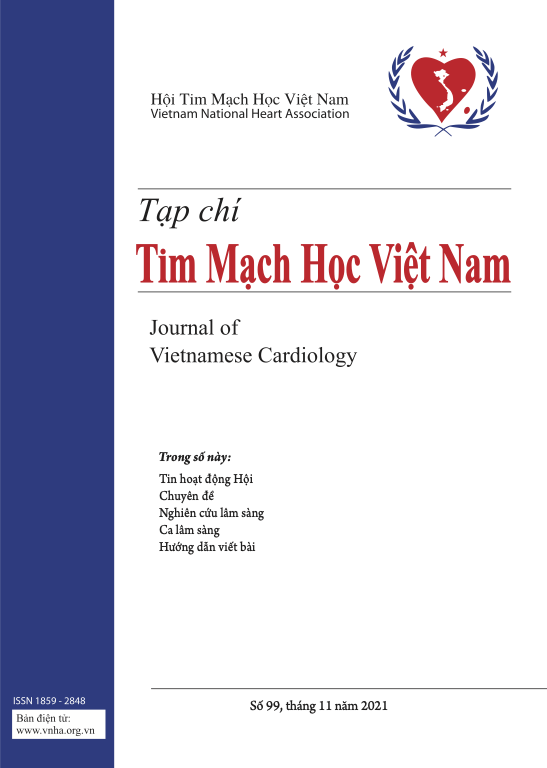SCAI cardiogenic shock classification for predicting short-term mortality in acute myocardial infarction
DOI:
https://doi.org/10.58354/jvc.112E.2024.880Từ khóa:
Cardiogenic shock, SCAI classification, acute myocardial infarction, mortality rate, prognosisTóm tắt
Background: Cardiogenic shock (CS) remains a critical complication of acute myocardial infarction (AMI) with severe outcomes. The Society for Cardiovascular Angiography and Interventions (SCAI) classification is a valuable tool for assessing the severity and progression of CS.
Objectives: Our study aimed to evaluate the association between initial SCAI classification and 30-day mortality in AMI patients and assess the prognostic value of SCAI changes within 24 hours post-admission.
Methods: All patients with AMI were classified according to the SCAI stages at admission and re-evaluated after 24 hours. 30-day mortality rates were compared across SCAI stages, and Cox regression analysis was used to assess the risk of death based on 24-hour transition SCAI classification.
Results: At admission, among 232 AMI patients, 50.8% were classified as SCAI A, 21.6% as SCAI B, 23.3% as SCAI C, and 4.3% as SCAI D/E. The 30-day mortality rates for each classification were 1.7% for SCAI A, 30.0% for SCAI B, 68.5% for SCAI C, and 90% for SCAI D/E. Within 24 hours of admission, 14.5% of patients experienced a worsening SCAI stage, 73.4% remained unchanged SCAI, and 12.1% showed improved SCAI. Patients with a worsening SCAI classification had a significantly higher risk of 30-day mortality, with an adjusted hazard ratio (HR) of 50.4 compared to those with stable SCAI status (p log-rank = 0.00001). Conversely, patients with stable or improved SCAI stages had notably lower mortality rates.
Conclusion: The initial SCAI stage at admission and its changes within 24 hours are crucial predictors of 30-day mortality in AMI patients with CS.
Tài liệu tham khảo
Vahdatpour C, Collins D, Goldberg S. Cardiogenic Shock. J Am Heart Assoc. 2019;8(8):e011991. doi:10.1161/JAHA.119.011991
![]()
Sciaccaluga C, Mandoli GE, Ghionzoli N, et al. Risk stratification in cardiogenic shock: a focus on the available evidence. Heart Fail Rev. 2022;27(4):1105-1117. doi:10.1007/s10741-021-10140-7
![]()
Hochman JS, Sleeper LA, Webb JG, et al. Early revascularization in acute myocardial infarction complicated by cardiogenic shock. SHOCK Investigators. Should We Emergently Revascularize Occluded Coronaries for Cardiogenic Shock. N Engl J Med. 1999;341(9):625-634. doi:10.1056/NEJM199908263410901
![]()
Thiele H, Zeymer U, Neumann FJ, et al. Intraaortic balloon support for myocardial infarction with cardiogenic shock. N Engl J Med. 2012;367(14):1287-1296. doi:10.1056/NEJMoa1208410
![]()
Bauer T, Zeymer U, Hochadel M, et al. Use and outcomes of multivessel percutaneous coronary intervention in patients with acute myocardial infarction complicated by cardiogenic shock (from the EHS-PCI Registry). Am J Cardiol. 2012;109(7):941-946. doi:10.1016/j.amjcard.2011.11.020
![]()
Ponikowski P, Voors AA, Anker SD, et al. 2016 ESC Guidelines for the diagnosis and treatment of acute and chronic heart failure: The Task Force for the diagnosis and treatment of acute and chronic heart failure of the European Society of Cardiology (ESC)Developed with the special contribution of the Heart Failure Association (HFA) of the ESC. Eur Heart J. 2016;37(27):2129-2200. doi:10.1093/eurheartj/ehw128
![]()
Ouweneel DM, Eriksen E, Sjauw KD, et al. Percutaneous Mechanical Circulatory Support Versus Intra-Aortic Balloon Pump in Cardiogenic Shock After Acute Myocardial Infarction. J Am Coll Cardiol. 2017;69(3):278-287. doi:10.1016/j.jacc.2016.10.022
![]()
Thiele H, Akin I, Sandri M, et al. PCI Strategies in Patients with Acute Myocardial Infarction and Cardiogenic Shock. N Engl J Med. 2017;377(25):2419-2432. doi:10.1056/NEJMoa1710261
![]()
Lee JM, Rhee TM, Hahn JY, et al. Multivessel Percutaneous Coronary Intervention in Patients With ST-Segment Elevation Myocardial Infarction With Cardiogenic Shock. J Am Coll Cardiol. 2018;71(8):844-856. doi:10.1016/j.jacc.2017.12.028
![]()
Baran DA, Grines CL, Bailey S, et al. SCAI clinical expert consensus statement on the classification of cardiogenic shock: This document was endorsed by the American College of Cardiology (ACC), the American Heart Association (AHA), the Society of Critical Care Medicine (SCCM), and the Society of Thoracic Surgeons (STS) in April 2019. Catheter Cardiovasc Interv. 2019;94(1):29-37. doi:10.1002/ccd.28329
![]()
Burkhoff D, Garan AR, Kapur NK. The SCAI Cardiogenic Shock Staging System Gets Taken for a Test Drive. J Am Coll Cardiol. 2019;74(17):2129-2131. doi:10.1016/j.jacc.2019.08.1020
![]()
Naidu SS, Baran DA, Jentzer JC, et al. SCAI SHOCK Stage Classification Expert Consensus Update: A Review and Incorporation of Validation Studies: This statement was endorsed by the American College of Cardiology (ACC), American College of Emergency Physicians (ACEP), American Heart Association (AHA), European Society of Cardiology (ESC) Association for Acute Cardiovascular Care (ACVC), International Society for Heart and Lung Transplantation (ISHLT), Society of Critical Care Medicine (SCCM), and Society of Thoracic Surgeons (STS) in December 2021. J Am Coll Cardiol. 2022;79(9):933-946. doi:10.1016/j.jacc.2022.01.018
![]()
Thygesen K, Alpert JS, Jaffe AS, et al. Fourth universal definition of myocardial infarction (2018). Eur Heart J. 2019;40(3):237-269. doi:10.1093/eurheartj/ehy462
![]()
Collet JP, Thiele H, Barbato E, et al. 2020 ESC Guidelines for the management of acute coronary syndromes in patients presenting without persistent ST-segment elevation. Eur Heart J. 2021;42(14):1289-1367. doi:10.1093/eurheartj/ehaa575
![]()
Jentzer JC, Wiley BM, Anavekar NS, et al. Noninvasive Hemodynamic Assessment of Shock Severity and Mortality Risk Prediction in the Cardiac Intensive Care Unit. JACC Cardiovasc Imaging. 2021;14(2):321-332. doi:10.1016/j.jcmg.2020.05.038
![]()
Schrage B, Dabboura S, Yan I, et al. Application of the SCAI classification in a cohort of patients with cardiogenic shock. Catheter Cardiovasc Interv. 2020;96(3):E213-E219. doi:10.1002/ccd.28707
![]()
Thayer KL, Zweck E, Ayouty M, et al. Invasive Hemodynamic Assessment and Classification of In-Hospital Mortality Risk Among Patients With Cardiogenic Shock. Circ Heart Fail. 2020;13(9):e007099. doi:10.1161/CIRCHEARTFAILURE.120.007099
![]()
Jentzer JC, van Diepen S, Barsness GW, et al. Cardiogenic Shock Classification to Predict Mortality in the Cardiac Intensive Care Unit. J Am Coll Cardiol. 2019;74(17):2117-2128. doi:10.1016/j.jacc.2019.07.077
![]()
Morici N, Frea S, Bertaina M, et al. SCAI stage reclassification at 24 h predicts outcome of cardiogenic shock: Insights from the Altshock-2 registry. Catheter Cardiovasc Interv. 2023;101(1):22-32. doi:10.1002/ccd.30484
![]()
Baran DA, Long A, Badiye AP, et al. Prospective validation of the SCAI shock classification: Single center analysis. Catheter Cardiovasc Interv. 2020;96(7):1339-1347. doi:10.1002/ccd.29319
![]()
Hanson ID, Tagami T, Mando R, et al. SCAI shock classification in acute myocardial infarction: Insights from the National Cardiogenic Shock Initiative. Catheter Cardiovasc Interv. 2020;96(6):1137-1142. doi:10.1002/ccd.29139
![]()








